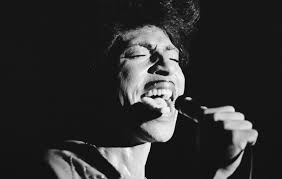
The great, the one-and-only Little Richard has died, but the beauty of what he did for rock and roll lives on forever, and I join millions of people worldwide in expressing my love for him.
I believe the reason Little Richard is so loved is that, as artist, he did what we are longing to do in our lives: have big, powerful, authentic feeling and show it in a way that is unfettered, unfiltered, uncompromised, and yet has accuracy and style.
Like everything I write here, what I’m saying is based on this great principle of Aesthetic Realism, stated by its founder, Eli Siegel: “All beauty is a making one of opposites, and the making one of opposites is what we are going after in ourselves.”
Little Richard is the giant, the hero of rock and roll that he is because of the way—in his greatest recordings and performances—he put opposites together; such opposites as wildness and exactitude, logic and emotion, inner feeling and outward blare.
When we hear him almost turn himself inside-out on such classics as Long Tall Sally, Lucille, or Good Golly Miss Molly (just to name a glorious few), there is something so staggeringly entire, so ALL OUT in his singing, that it thrills us to our core. It sounds like pain, but it feels like joy! That, my friends, is rock and roll.
In an Aesthetic Realism lesson he gave in 1969, Eli Siegel said of rock and roll, “If you listen to it there seems to be the utmost pain and the utmost assertion.” He called it “the blare of agony.” And he asked the man having the lesson (who was a rock musician), “Do you believe that there’s a desire for a person to unburden himself as if he were an earthquake?” That is such a description of Little Richard!
Continuing, Mr. Siegel said, “There is a desire to take one’s private life and to have a train caller give it.” Isn’t this why we love Little Richard? Don’t we want to take the turmoil, pain, confusion, frustration we have inside and find some way to let it out—not in a sloppy, ugly way, but in an honest way? When we hear Little Richard sing at his most high-voltage intensity, we also feel a sincerity that makes it feel right, well-formed; it satisfies our ears and minds at once.
I think he would be very proud to know that beyond the “flamboyance,” beyond all the frivolity and high-flying fun of his music, there is a deep encouragement for every human being, a means for us to be better people. The knowledge of Aesthetic Realism is what makes that clear, and I’m grateful to know it. I see Little Richard as a man of great courage. He got in front of that piano and microphone and wanted to hold nothing back—and he succeeded to very large degree. In fact, I think there is no person—even after all these decades of rock and roll—who has ever surpassed or even equaled him in that regard.
So, dear Little Richard, I salute you and thank you with all my heart.
We’re forever in your debt.
Rock in peace.
Here’s a link to my paper, Wildness and Precision – Little Richard’s “Good Golly Miss Molly”
Learn more: AestheticRealism.org
I love the all out, exact praise you give a true artist in this tribute to Little Richard. Thank you. Eli Siegel’s understanding of why we love Rock and Roll is so right!
So glad to read this. I’ve loved his music and through what you write I now understand why. And it makes for even more feeling about his music.
I love what you wrote. It made me cry! xoxo
I always liked Little Richard, but I value him so much more through what you write. The things Eli Siegel said to a rock musician that you quote here show that not only is Little Richard’s music irresistibly fun–the message of his music is important! Thanks!